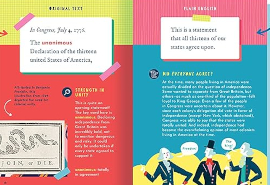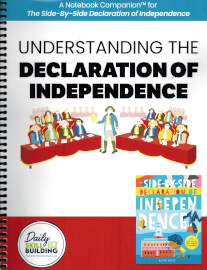The Side-By-Side Declaration of Independence and Understanding the Declaration of Independence: A Notebook Companion™ for The Side-By-Side Declaration of Independence work together as a complete course for grades four through ten. The Notebook Companion is entirely dependent on The Side-By-Side Declaration of Independence. Students read from the book, then write and draw in the Notebook Companion.
The time it takes to complete the course depends on how much a student can accomplish in each session as well as the number of optional activities students pursue. Many students will be able to work independently through the course, but younger students might need further explanation or discussion.
The Side-By-Side Declaration of Independence
The Side-By-Side Declaration of Independence by David Miles (published by Bushel & Peck Books) truly makes it easy to understand one of the most important documents in U.S. history. At first glance, the book seems written for young children, but it’s not. The publisher recommends it for ages eight to twelve, but I would shift the recommended range up to ages nine through fifteen because of the vocabulary, the ideas, and the need for some historical background. I think older students will appreciate its interpretation of the document with additional comments that provide contexts for understanding it.
 This 96-page, hardcover book is heavily illustrated with bold colors and graphics. It includes images of people, paintings, political cartoons, maps, and photos. The first few pages set the stage for the writing of the Declaration of Independence. The bulk of the book “translates” the document bit by bit, with the original text on the left-hand page and a “plain English” simplification on the right. Images and explanations surround the text on both pages. Many of them provide historical background (highlighted by a “Learn the History” icon) to help students understand why particular ideas were included. For example, a line in the Declaration of Independence reads, “He has made Judges dependent on his Will alone, for the tenure of their offices, and the amount and payment of their salaries.” A historical note explains: “In Massachusetts, King George took control of the court system…. One of the ways he did this was by paying the judges himself instead of letting the people pay them. As you might imagine, this put pressure on local judges to cooperate with King George’s decrees.” (p. 41).
This 96-page, hardcover book is heavily illustrated with bold colors and graphics. It includes images of people, paintings, political cartoons, maps, and photos. The first few pages set the stage for the writing of the Declaration of Independence. The bulk of the book “translates” the document bit by bit, with the original text on the left-hand page and a “plain English” simplification on the right. Images and explanations surround the text on both pages. Many of them provide historical background (highlighted by a “Learn the History” icon) to help students understand why particular ideas were included. For example, a line in the Declaration of Independence reads, “He has made Judges dependent on his Will alone, for the tenure of their offices, and the amount and payment of their salaries.” A historical note explains: “In Massachusetts, King George took control of the court system…. One of the ways he did this was by paying the judges himself instead of letting the people pay them. As you might imagine, this put pressure on local judges to cooperate with King George’s decrees.” (p. 41).
Some notes identified by a “Look Closer” icon expand on vocabulary words. For instance, the Declaration begins, “The Unanimous Declaration of the thirteen united [sic] States of America….” The book points out the meaning and importance of the word unanimous. On the next page, a historical note explains that perhaps as much as a third of the population was still loyal to King George. And when delegates voted for their states, New York abstained. Technically, it was still a unanimous vote by the other delegates, but everyone in the country wasn’t in favor of independence.
“Think Deeper” icons accompany thought-provoking questions, such as the one on page 59 that asks, “What do you think are some of the pros and cons of a trial by jury versus a trial with a single judge?”
The final lines of the Declaration are printed on top of John Trumbull’s famous painting showing the presentation of the Declaration of Independence to the assembly. Eleven figures in the painting are highlighted with numbers. The next two pages of the book reveal what happened to those signers in subsequent years. It also points out that nine of the 56 signers died fighting in the Revolutionary War or from related hardships, and twelve had their homes destroyed by the British.
While students as young as eight might understand much of the book, many concepts, such as the question about jury trials, require more maturity and experience before students can form an opinion. Looking at the older end of the spectrum, many of the historical details and explanations are likely to be unfamiliar to some high school students, so I wouldn’t hesitate to use it with them.
Understanding the Declaration of Independence: A Notebook Companion™ for The Side-By-Side Declaration of Independence
 Understanding the Declaration of Independence: A Notebook Companion™ for The Side-By-Side Declaration of Independence (which I will call the Notebook Companion for brevity) is a 195-page notebook by Carrie Fernandez and WriteBonnieRose (published by Daily Skill Building) in which students write answers to questions, create drawings, do copywork, and label a map. They also write definitions in the glossary pages at the end of the book.
Understanding the Declaration of Independence: A Notebook Companion™ for The Side-By-Side Declaration of Independence (which I will call the Notebook Companion for brevity) is a 195-page notebook by Carrie Fernandez and WriteBonnieRose (published by Daily Skill Building) in which students write answers to questions, create drawings, do copywork, and label a map. They also write definitions in the glossary pages at the end of the book.
This is not a notebook that requires gathering or creating items, and there’s no cutting and pasting. Rather it helps students complete its 43 lessons as they read through The Side-By-Side Declaration of Independence, usually two pages at a time.
The lessons each have three to five pages and conclude with optional Bonus Projects. (An exception is the combined Lessons 41 and 42, which offer more pages for drawings but no Bonus Projects.)
In all except the first two and last three lessons, students are provided with lines to copy the section of the Declaration of Independence under study as well as the “plain English” version of those lines. They also have a few comprehension questions to answer based on The Side-By-Side book. There is no answer key, but it should be easy enough for parents to scan the book to check answers. Some lessons have large squares in which students are told to write vocabulary words and definitions from the book. They are also told to write the definitions in the glossary. (Personally, I doubt I’d have students write the definitions twice.)
Some drawings should be easy, such as drawing “a ship traveling from the colonies to Great Britain” on page 117. Others that require drawing people might be more challenging for students. For instance, the combined Lessons 41 and 42 ask students to draw all eleven of the people highlighted in Trumbull’s painting. (I would allow students who lack the drawing skills to print images from the internet and paste them in.)
The Bonus Projects section at the end of most lessons tells students to choose one or more from two or three options. Projects are listed under either Research Projects or Writing Prompt. I’ll provide examples from page 109 which lists two two research projects and one writing prompt. The research projects are:
- See what you can learn about Benedict Arnold and write a short essay about his life.
- Why were the colonies not able to produce their own tea and sugar? What parts of the world do these crops grow in, and where did most of the tea and sugar in colonial times come from?
The single writing prompt says, “Imagine you are a smuggler trying to get illegal tea and sugar into the colonies. What might a day in your life look like?”
Some writing prompts are easier than this, such as the one on page 115 that tells students to answer the question on page 59 of The Side-By-Side book (quoted above) regarding juries versus judges.
While some Bonus Projects won’t take much time, most will, so parents need to decide how many to require. For instance, with older students completing the course over two semesters, I might have them do all writing prompts that ask them to answer questions in the book, then also have them choose one from each category per month. With younger students, I might do research with them on one project a month and assist them as they summarize their findings.
The Notebook Companion is available as a spiral-bound printed book or as a PDF. Purchasers of either format receive for free the American Revolution Coloring Notebook PDF with 21 coloring pages and 21 corresponding notebooking pages for figures like Abigail Adams, Ethan Allen, Crispus Attucks, Samuel Adams, and Sybil Ludington.
Summary
Used together, The Side-By-Side Declaration of Independence and Understanding the Declaration of Independence: A Notebook Companion™ make a great course that bridges the subjects of history and government. The hardcover book makes studying the Declaration of Independence interesting, and the Notebook Companion reinforces and documents learning.









